CARRY TWO CAMERAS EFFORTLESSLY
Cotton Carrier --
The Invisible Assistant
By MIKE PASINI
Editor
The Imaging Resource Digital Photography Newsletter
Review Date: November 2009
Every time we grab a camera to take a little hike with us, the same conundrum stops us dead. How are we going to carry it?
You would think that would be easy to answer.
But it's only an easy question when the camera is ultracompact and slips into one of our empty pockets. As soon as we get into the G11 or long zoom digicam size, we're in trouble.
Manufacturers supply either a shoulder strap or a wrist strap, of course. We prefer wrist straps because they offer protection against drops and are not obtrusive. Shoulder straps tend to get in the way or suddenly lose interest in their assigned task. Even the sure-grip UPstrap, while secure, is heavy and can pull the strap down your back instead of sit on your shoulder when you shift positions.
So we tend to holster a camera with a wrist strap. But we also use the UPstrap, swinging the camera off our hip until it's time to shoot.
There's one word for all of these approaches: awkward.
So we were intrigued the other day when we received an email from Cotton Carrier introducing us to their camera harness. "The Cotton Carrier holds one or two cameras of any size and lens combination comfortably and securely," the company told us, "alleviating all of the pain and discomfort created by traditional neck strap systems."
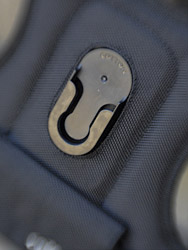
Lexan Hook. Your camera locks into this hook.
They've sold over 2,000 units since they started selling the product in June "and the feedback from photographers at all levels has been phenomenal.
We took a look at the Web site, which includes links to a couple of quite helpful videos demonstrating how to fit and use the product, and decided to give it a shot. We had just been corresponding with a few newsletter subscribers about ways to carry a camera on horseback and thought this might be a terrific solution. If it worked.
The $139 unit, which includes a one-year warranty, arrived a few days later from Western Canada with an instruction sheet printed on both sides.
There are two kinds of camera accessories. Some are designed by people sitting in Herman Miller chairs running CAD programs all day. They produce things that sound like great ideas but end up in the drawer before the credit card bill shows up.
The other kind are designed by photographers who are trying to solve a problem that vexes them. Sometimes the photographer has an expertise that extends beyond duct tape and a really useful solution finds its way to the rest of us.

Front. Four adjustable straps.
Although we had our doubts about the Cotton Carrier concept, we very quickly found out this was the second kind of solution built by a guy who is way beyond duct tape.
It arrived in a lightweight mesh bag that keeps the octopus-like harness tidy if you want to travel with it.
Along with the instruction sheet, the mesh bag contained the harness itself and a holster plus two camera inserts. There are business cards with the inserts and in the harness, too.
The harness is composed of a chest plate covered in 1650 Denier fabric with 20 oz. webbing straps and heavy-duty nylon buckles, the same stuff you see in heavy duty camera backpacks. Cotton recommends hand washing it in regular laundry detergent and hanging it up to dry, which it does quickly. The company warns against machine washing and drying.
The harness's secret weapon is the Lexan receptacle in the breast plate.
The receptacle is a three-inch hook that snags the round camera inserts that machined from hard anodized, powder coated aluminum with stainless steel screws and a rubber gasket for mounting in the tripod socket of your camera.
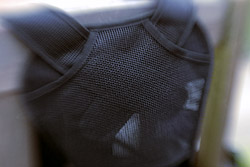
Back. Shoulder straps cross and attach with Velcro.
Every camera has a tripod socket, after all, and it's usually unoccupied. If you're using a quick release plate, it may even be compatible with the insert. But more about that later.
The insert itself has an arrow engraved on it to indicate the release direction. You align the arrow so when the insert is tightened against the camera body it points in the direction you will slide the camera. That can be holding the grip up and lens pointing right or holding the grip low with the lens pointing left, either way.
We gave the insert about a quarter turn with a coin inserted in the slot to tighten it against the body. The last thing you want is a loose insert because that defeats the release system.
The release system actually locks the camera into the mating receptacle on the harness or the holster. You slide the camera into the receptacle and twist it 45 degrees to lock it. To release it, you twist the camera 45 degrees back and slide it up. You can do it blind-folded. And quickly.
In the video, Cotton recommends lubricating new systems with, well, anything. We didn't find that necessary but if we had, we would have used a silicon spray on a rag to wipe the mating surfaces down.
The trouble with that, of course, is that lubricants of any kind attract dirt. And you won't typically be wearing the Cotton Carrier in a clean room. You'll be out in the woods. So we skipped that recommendation and lived to tell about it.
We had a difficult time fitting the harness to our athletic build. We had a harder time fitting it on a couple of friends, too.
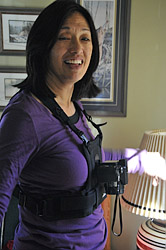
On Women. "It's comfortable, Mike," Alice reported.
It's time well spent, of course, because once you've fitted it, you're in business. You won't really want to share the harness.
The trouble we had involved getting the lower belt snug. There are three possible adjustments: one on the buckle, one in the back to the right of the mesh back and another to the left of the mesh back.
This is the critical adjustment because, as the Cotton video demonstrates, the two shoulder straps really don't bear any weight. You can detach them and the camera will still sit there right in front of you. We suspect that's also why women are able to wear the Cotton Carrier comfortably (we found a few volunteers to confirm). The chest plate doesn't have to press tightly against your chest.
But you do have to get a snug fit with the bottom belt on your rib cage. And eventually we did. But it wasn't easy.
We had a little more trouble with the shoulder straps. They are attached to the harness in the back by Velcro. A Velcro bed grabs the ends of the straps under a mesh covering. That lets you lengthen or shorten the straps a bit, but we barely got them short enough. The shoulder straps merely stabilize the harness, so it wasn't a big deal, but would have been inclined to make them tighter.
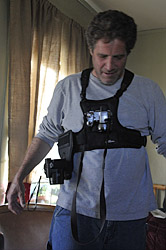
On Men. Packing two cameras and quick on the draw.
So we felt as if we had a harness that was a little big for us, but we eventually got a good fit on the bottom belt and a comfortable one with the shoulder straps.
It was subsequently a snap to get in and out of, though. Just duck into the gap between the shoulder straps, bring the belt around and snap it in. Done.
With a correct fit, we found the harness was quite comfortable. We wore it all day the first day as we worked around the studio and even took a nap in it. It's very light, doesn't cover a lot and is really only stiff in front with the chest plate.
INSERT FITTING | Back to Contents
We attached the camera insert to half a dozen cameras ranging from long zoom digicams to small dSLRs to pro-level dSLRs with horizontal grips. We also screwed it into a wrist strap insert that was already occupying the tripod socket. Our particular quick release system isn't compatible with the camera insert, so we didn't give that a try.
Cotton told us Arca-Swiss systems (Really Right Stuff, Kirk, etc.) work well with the inserts. And while Cotton sells a tripod quick release clamp from Kirk, Kirk plans to provide a "Cotton Carrier" logo version shortly.
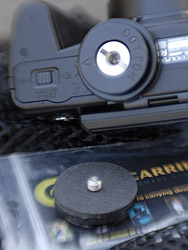
Camera Inserts. Mounted (top) shows arrow at left edge and stainless steel bolt. Unmounted (bottom) shows rubber gasket.
At first, we just hand tightened the insert. But that really wasn't sufficient to keep it tightened after slipping it in and out of the receptacle a few times. So we resorted to a casino token we keep handy for unlocking and locking scanners. A quarter works well, too. A quarter turn did the trick except on the wrist strap.
But that one failure was really the fault of our wrist strap, which does not have a rubber gasket to compress it tightly to the camera body like the insert itself has. We suspect an application of a thread locker would have done the trick. Cotton recommends LocTite 425 because it is non-permanent and non-corrosive to plastics and polycarbonites.
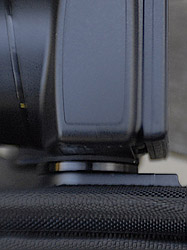
Insert Locked. From top to bottom: camera bottom, rubber gasket, shiny black metal insert, Lexan lock, Denier fabric.
It's a remarkably well-made insert, we have to say. The black metal housing is round with a flange to press the rubber gasket against the camera body or grip and another flange with the arrow indicator. Between the flanges of the same metal piece is a slot whose round interior has two sides shaved straight so the insert can slide into the receptacle. You have to look closely to notice. The stainless steel bolt turns independently of the black metal housing and has a slot for casino tokens, quarters and other leverage.
The one time we could not remove the camera by twisting it (because our grip bolt had come loose), we could not just turn the black housing to unscrew the insert. It spins freely. We had to rotate the camera to release it from both bolts and then slide the insert out.
So you really want a tight fit. Don't be shy.
A holster with the same Lexan receptacle is included in the $139 package and available separately for $59 (the harness is also available separately for $99).
The holster has two flaps on the back that lock around a belt or the lower belt of the harness. The flaps are not reinforced in any way (like, for example, the Think Tank Photo accessories) but that didn't seem to matter.
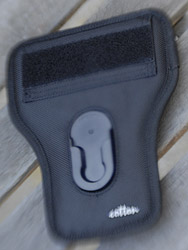
Holster. Convenient for carrying a second camera.
Among the people we asked to try the arrangement, only one person preferred the holster. He happened to be someone who wears a tool belt all day and that felt familiar to him.
But everyone else preferred the harness mount because it was unobtrusive and weightless.
So what exactly can you carry with the harness and the holster?
Cotton says it has tested the unit with a 5.8 lb. Canon Mark III 1Ds with an 11.7 lb. Canon EF 400mm f2.8 IS lens (17.5 lbs. total). We put a D200 with a horizontal grip and an 18-200mm Nikkor lens on it. We also mounted a Nikon P90 long zoom, a Sony long zoom, a Canon Rebel XTi, a Nikon D300 and a few smaller digicams.
The bigger the camera/lens combo, the more you'll want it on the chest receptacle, which does not flop around like the holster. The holster, as Cotton demonstrates in one of its videos, tends to swing the camera. Your arm tends to swing, too, so a large protrusion from your hip or side can be an obstacle.
But mounted to your chest, you hardly feel the weight. It's a remarkably comfortable location, almost as if the camera were floating in front of you, cared for by an invisible assistant who was able to hand it to you instantly whenever you wanted.
The only caveat to add to that glowing description is that we didn't feel nearly as comfortable with the full grip/camera/long lens rig as we did with a camera/long lens. The grip really pushed the camera out from our body quite a bit. It wasn't less secure, but it felt more, um, awkward.
And awkward is just not how we usually felt with the Cotton Carrier.
In fact, it was almost fun to carry two cameras with it. We mounted a D300 on the harness and with the holster attached to the side of the harness carried a long zoom digicam. Either camera was instantly available with just a twist. Very nice.
And nothing like it.
Cotton recommends that you continue to use your shoulder strap along with the harness until you're confident the system is secure. It's an excellent tip and the harness even has a few loops on the shoulder straps to attach a strap or cord to prevent your camera from falling to the ground should you drop it.
Despite being safely behind the lens most of the time, you may be wondering if wearing the harness makes you look like a dork or makes you look cool.
Depends where you wear it, actually.
The second day we had it, we mountain biked up Twin Peaks with a long zoom hanging like landing gear from our chest. The harness worked wonderfully, securing the camera to us without preventing us from using it. We simply pulled up, twisted the camera out, took a shot, twisted it back into the harness and rode on.
Compared to carrying a camera in a backpack, this was a different world.
And as we biked up the hill or came screaming back down, we had no worries about losing the camera. It was locked to our chest.
On the other hand, it wasn't something we felt comfortable with walking through the neighborhood or the village or using on public transportation. Any place where you want to remain inconspicuous, that is.
It's hard to miss and by its nature, not something you cover up, although you can wear an open jacket over it.
Everyone who tried it loved how weightless the Cotton Carrier harness made their camera seem. They all found it easy to mount or unlock the camera from the harness. It was one of those products everyone liked the minute they tried it.
The holster is a welcome addition but not quite the same thrill as the harness. You do feel the weight, although it is just as simple to attach the camera and remove it.
But the two together provide the simplest, most secure way of using two cameras that we've found.
While not inconspicuous, if you don't mind drawing attention to yourself (as, say, the wedding photographer) or are out in the woods where no one would notice you anyway, there's no better way to carry a camera. Outright prolonged applause.